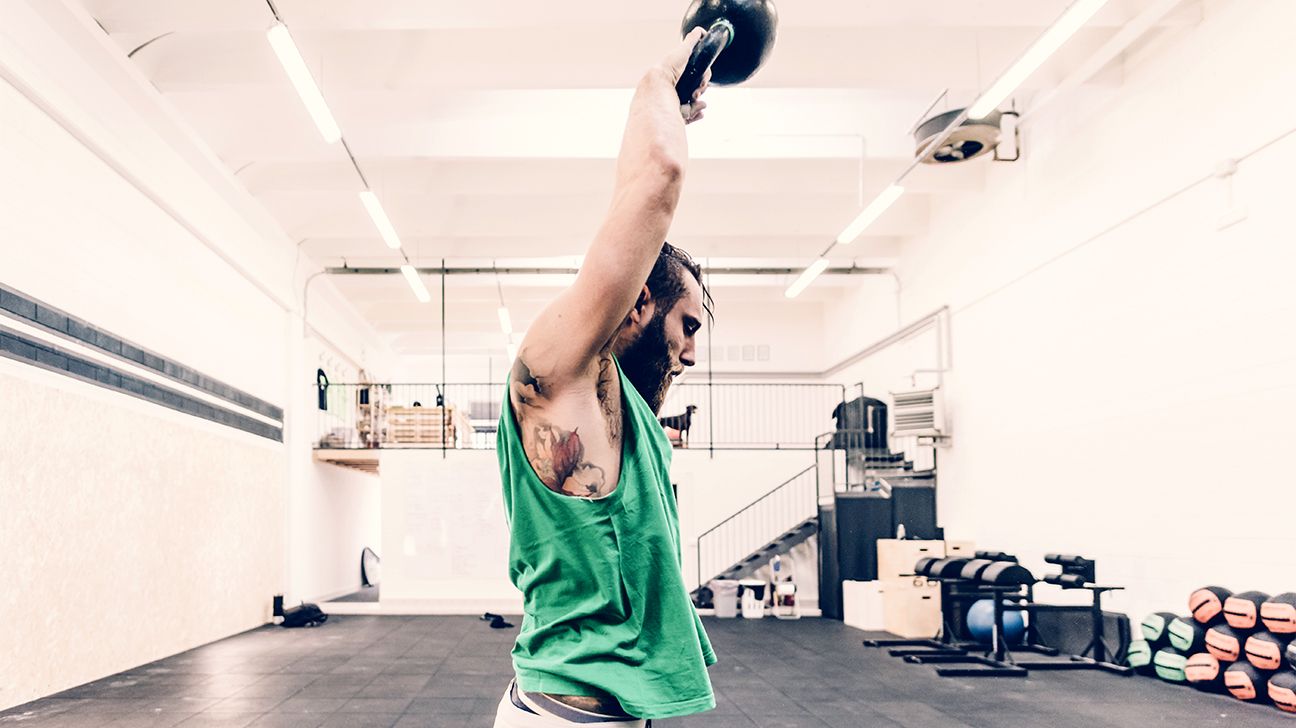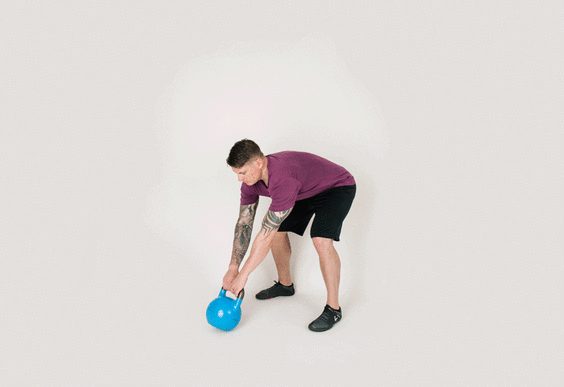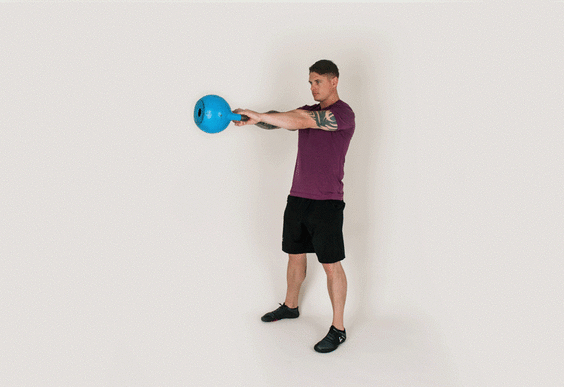We include products we think are useful for our readers. If you buy through links on this page, we may earn a small commission. Here’s our process.
Greatist only shows you brands and products that we stand behind.
Our team thoroughly researches and evaluates the recommendations we make on our site. To establish that the product manufacturers addressed safety and efficacy standards, we:- Evaluate ingredients and composition: Do they have the potential to cause harm?
- Fact-check all health claims: Do they align with the current body of scientific evidence?
- Assess the brand: Does it operate with integrity and adhere to industry best practices?
First things first. That cannonball-with-a-handle weight you’ve seen around the gym is a kettlebell, not a kettleball.
With that common misconception out of the way, let’s clear up another, because it’s not just the name of this old school-turned-trendy exercise tool that trips people up.

The preeminent kettlebell exercise — the two-handed swing — is notorious for leaving gym bunnies of all ages and ability levels scratching their heads, wondering, “You mean I don’t use my arms to swing this thing?” Yes, you hold the ‘bell with your hands.
But when it comes to properly swinging the kettlebell, what you’re really using is your legs. When performed correctly, kettlebell swings build total-body strength, power, and balance, while improving cardiovascular stamina, all with one piece of equipment, one study showed.
Until now, that is (*cue dramatic music and 😱😱😱 expression*).
With this step-by-step guide, you’ll learn to use your legs, hips, glutes, and core to perform the perfect kettlebell swing.
Russian-style swings are the safest, most effective way to master a kettlebell swing. Here’s how to absolutely nail a Russian kettlebell swing.
(Case in point: It’s the starting point of this nuts workout.)
The setup
Clearly, there’s a point in the workout when you aren’t holding a kettlebell yet. You aren’t Edward Kettlebellhands.
To avoid excessive strain on your back, avoid moving straight from leaning to pick up the kettlebell to brandishing aloft like a prize trinket in a video game.
Keeping the heels planted and engaging your core, bend your knees and grip the handle of the kettlebell.
Then, swing the weight from the floor backward between your legs.
From there, you can swing into your first rep…
The swing
- Stand tall, still gripping the ‘bell.
- Keep your arms long and loose while squeezing your shoulder blades together and engaging your core.
- Soften your knees, shift your body weight into your heels, and lower your butt back and down toward the wall behind you.
- Driving through your heels, explode through your hips to send the weight swinging upward from your quads. Aim for chest height, with your arms extended.
- Achieving this finishing position requires you to snap your hips through, contracting your core while squeezing your glutes.
- As the kettlebell begins to descend, let the weight do the work as you ready your body for the next rep. Shift your weight back into your heels while hinging at your hips and loading both your hamstrings and glutes.
- Receive the weight of the kettlebell, allowing it to ride back between your legs.
- As the kettlebell makes the transition from backward to forward, drive through your heels and hips to repeat.
Hips don’t lie: You aren’t using your arms
As it turns out, dancing the salsa and swinging a kettlebell have a lot in common. Okay, maybe “a lot” is pushing it.
But they do share a coaching cue that makes every movement possible: It’s all in your hips.
When it comes to the kettlebell swing, your hip action we’re referring to is a hinging motion. You know, like a hinge on a door.
Here’s a way to break down the movement as it should be:
- Think of your legs as the wall, solid and immovable.
- Your hips act as the hinge, enabling movement.
- Your torso is the door, traveling through a predetermined range of motion — dictated by both the wall (your legs) and hinge (your hips).
Add the kettlebell into the mix, allowing the swing to begin taking shape. With loose arms and a light grip, you swing the kettlebell from inside your quads up to your chest, just below eye level — in the Russian version anyway (more on this later).
The wrong way
The movement itself is a bit of an optical illusion. To the untrained eye, the swing appears to be a feat of upper-body strength: Simply squat and then stand up while pulling with your arms.
Be warned: This is not the case.
Performing the perfect kettlebell swing places all the emphasis on your posterior chain — your major muscles on the backside of your body from your heels to the base of your neck, primarily your hamstrings, glutes, and lower back.
Think of your posterior chain as your body’s powerhouse. These muscles are big movers. And unlike little movers (calves, biceps, triceps, and deltoids), big movers are capable of moving big weight and burning calories like there’s no tomorrow.
A total-body workout, with one piece of equipment? Yeah, right! We’ve heard that snake oil-laden sales pitch before. Not buying it?
Luckily, there’s nothing to buy. Well, except for a kettlebell. But the good news is, it’s a piece of fitness equipment that actually lives up to the hype.
Still not convinced? Consider this: A 2010 study analyzing the effectiveness of kettlebell exercise concluded that “kettlebells provide a much higher-intensity workout than standard weight-training routines and offer superior results in a short amount of time.”
The same study went on to say that the benefits of kettlebell training extend beyond strength and stamina by helping people “burn calories, lose weight, and enhance their functional performance capabilities.”
Not bad.
(But wings aren’t the only way through — here are 14 other kettlebell moves that can give you a cardio workout.)
There’s nothing like an arms (read: hips) race to create animosity among nations (or in this case, coaches and their respective exercise communities). But it’s your full-body fitness that comes out of this struggle as a global superpower.
This spat pits the Russian swing against the American swing in a battle for kettlebell victory.
- The Russian swing: This is the move described above, which you’re currently in the process of mastering. The movement originates at your groin and finishes at eye level.
- The American swing: This mirrors the motion of the Russian swing until the apex of the movement. Instead of stopping at eye level, the American swing finishes with your arms and kettlebell overhead.
Here’s the American swing in motion:
If you’re familiar with CrossFit, then you know this particular program is a proponent of the American swing.
A swing warning
Our expert Chris Finn, certified personal trainer at Life Time at Sky and StrongFirst level-two kettlebell instructor, never recommends the American swing due to the risk of injury to your shoulders.
That said, the decision on where to pledge your allegiance should be based on personal ability level and safety (and not patriotism at all — it’s just a name and your glutes don’t care).
Practice the Russian swing until perfection. Then, and only then, does defecting become a possibility.
Like most things, there’s a right way and a wrong way to use a kettlebell.
You’ve got to start by choosing the right kettlebell (catch our guide here).
Then, paying close attention to a proper swing will ensure a successful —not to mention injury-free — workout. Don’t make these common mistakes.
1. Bending your knees too much
It’s called a kettlebell swing, not a kettlebell squat. With that in mind, always drive and explode from your legs and hips.
Dropping to a squat turns it into an up-and-down movement rather than an explosive thrust.
2. Leaning back
If your back hurts, something is out of whack. Chances are you’re not bracing your core as you swing.
Start and finish the swing by loading, firing, and hinging at your hips. Be sure to keep your core tight throughout so you don’t strain your lower back.
3. Swinging too low
You’re not aiming to scrape the bell across the floor. In fact, the bell should tap you in your butt if you’re doing it right (a-tee and a-hee and a-hee-hee-hee).
Don’t let the weight pull your hands between your knees. If it looks casual, you’re not doing it right.
You’d better bell-ieve that there’s a fine line between lower back injury and the ample benefits a good kettlebell swing can bring to your workout.
Remember to keep it Russian until you’re ready for the rigors of the American over-your-head swing. Your shoulders may not be able to take it otherwise. Shop for a kettlebell online.
Now, let’s get crackin’ with a full-body kettlebell workout.



